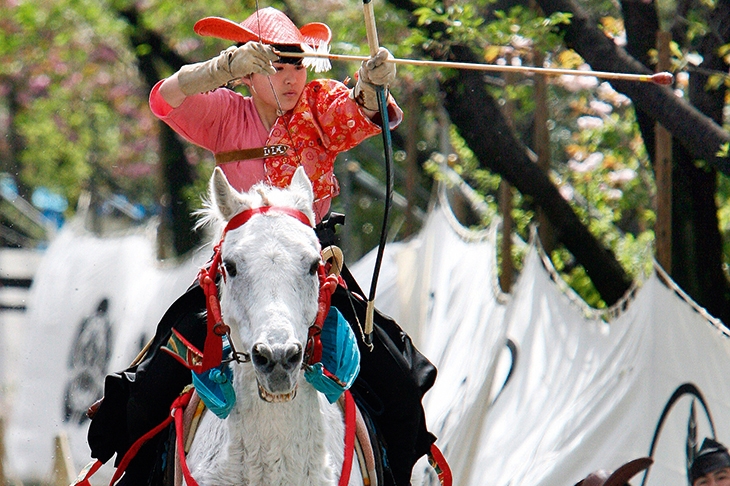Rumour will run wild about a society of warrior women, somehow free from the world of men. We all feel we know the Amazons, even if we struggle to connect them with the planet’s largest rainforest, river and internet company. But the historical reality of that thrilling and threatening tribe proves to be elusive. Even two millennia ago, the Greek geographer Strabo marvelled at his fellow men’s credulity about the Amazons: ‘the same stories are told now as in early times, although they are wondrous and beyond belief.’ Now John Man, the enthusiastic historian of Asia, dissects the Amazons with sharp scalpel and acute scepticism.
The Amazons were there from the start: for Homer they were antianeirai, ‘anti-men’; for Aeschylus ‘haters of men’. Heroes won their stripes by subduing these viragos: Achilles slew Penthesilea, the Amazonian queen; Hercules parted Hippolyte from her girdle; Theseus fended off a whole army from Athens. Lively lasses, then. But who were these Amazons? At once no one and everyone.
Andrew O’Hagan talks about his new book The Secret Life – a funny, alarming and disturbing picture of what happens when digital fantasy meets analogue reality. Plus, he reveals the truth about Julian Assange’s appalling table-manners:
The Amazons of epic couldn’t have existed: a male-free ‘society’ is a rogue band doomed to self-destruction by eschewing procreation. And yet the Greeks willed the Amazons into existence, not as a proto-feminist construct, but a reassuring thought experiment. They were the reverse of All Things Greek: unbounded, independent, virile women, challenging society’s boundaries from the world’s fringes.
The Greeks first set them in Asia Minor, by the river Thermodon (the Turkisk Terme) on the Black Sea, before transplanting them yet farther afield to the limits of the known. The Amazons were forever destined to be defeated. In Athenian legend, the city’s male valour completely extirpated the tribe — and thus the threat of weaponised womanhood.
Man dismisses such tales as ‘rubbish’, and the legendary Amazon custom of removing the right breast for marginal gains in archery is also ‘rubbish, nonsense, balderdash, tosh, twaddle’. Instead, we have here a species of nominative determinism: their mysterious name of unknown (possibly Iranian) etymology left Greeks grasping at a-mazos (‘without-breast’) and letting the story flow from there.
Man must therefore look elsewhere for an Amazon thread. Like the Greeks themselves, he turns to the Sarmatians for answers, a Scythian people who included fighting women in their ranks. Herodotus — always a lively source — shudders at their Scythian name Oreopata (‘man-killers’). But they proved a worthy canvas for Amazonian fantasies: from the 6th century BC, Amazons start to be depicted in markedly Scythian garb.
These ‘Scythians’ were a loose association of Iranian nomads, ranging across the steppe from the Black Sea to Mongolia. To learn more of them we must prise open — and defrost — their burial tombs. The bodies that have escaped looting reveal many females with weaponry. But these ‘real warrior women’, who can be ‘Amazons, if you like’, prove to be something of a damp squib: women and girls who could ride and shoot, fighting either with their men or in their absence. A model more of equality of training, not of feminine supremacy or a matriarchal society. Lest we get excited, Man reminds us that ‘the Amazons, being mythical, could not have mated with the Scythians’. Similarly, the Amazon-hunter’s excitement about the ‘Ice maiden’ soon melts: this Ukok princess was not a warrior, but a priestess covered in silk, wig, eyeliner and tattoos.
A fifth of the book treats the Ancient Greek world, a fifth the Scythians. But with a commission to complete, Man must take inspiration from the Scythians and wander elsewhere. He goes on to cover modern women who practise horseback archery; the New World belief that ‘very white and tall’ Amazons lurked in South America; the battle scenes (or Amazonomachies) painted by Rubens; the Amazonian plays of Anne-Marie du Boccage and Heinrich von Kleist; the warrior women of Benin; the ‘Night witches’, Russia’s women-only 588th Night Bomber Regiment of the second world war and (of course) Wonder Woman, ‘Queen of the Amazons’. This interesting romp is nevertheless a haphazard journey. When Man at last interjects ‘bear with me: it’s relevant’, we are forced to say with a sigh, ‘it’s not’.
Inevitably, interesting facts tumble forth, and often surprise: that Marcus Aurelius sent some 5,000 Sarmatians to northern England on military service, many of whom settled in Ribchester, near Blackburn; that liberal California ultimately takes its name from the Islamic Caliphate; that every day the river Amazon pours forth enough fresh water to give every living person 3,000 litres. The prose style is at times vivid and personal, but others oddly pedantic:
On the flanks of Mt Kotilon (1,226 metres high), at a place called Bassai (now better known in its Latin spelling, Bassae), a platform of rock gives terrific views over mountains to the sea.
For all of this colour, Man fails to tackle the most interesting question that arises: why did the fictional Amazons really mean so much to the Greeks, who established tombs, shrines, festivals and foundation myths in their name?
The blurb advertises a ‘deeply researched, sweeping historical epic’. Although I happened to read this book in a Mongolian ger, I struggled to be carried along. Adrienne Mayor’s Amazons (2014), buried in the bibliography, remains much the best guide to the Amazonian blend of fact and fable. Instead, this magpie-minded, restless book leaves one thinking, like the Amazons, that there’s not much scope for Man.






Comments